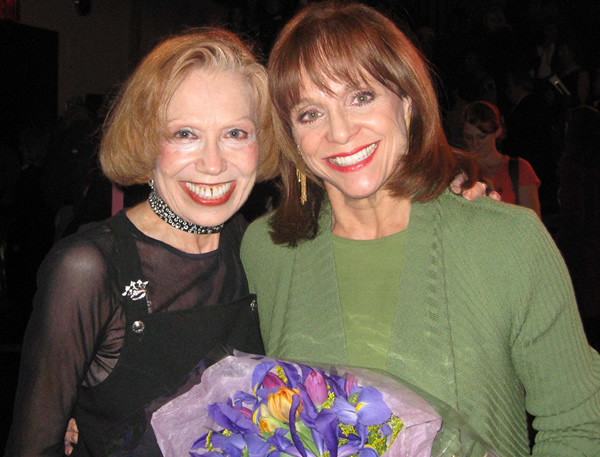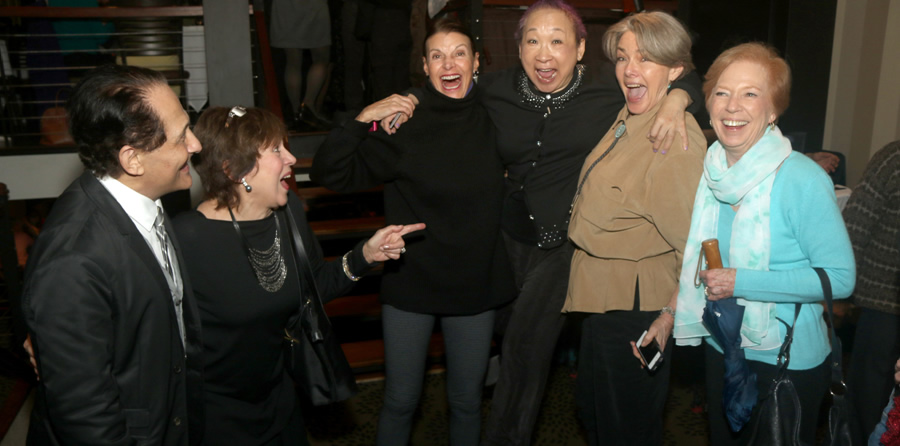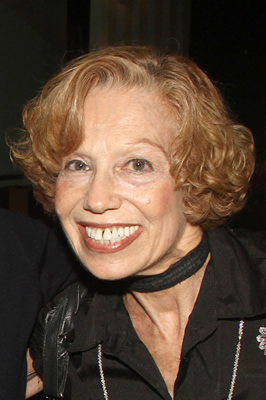In Memoriam #1
| BACK TO MEMORIAM | NEXT MEMORIAM |
A WONDERFUL OUTPOURING OF LOVE CELEBRATING
THE LIFE, LOVE AND FRIENDSHIPS OF
NICOLE BARTH
NICOLE BARTH
Friends, Family, DO40 Members and more came together Sunday, January 18th
at the Glass House Tavern to show their Love for Nicole
CLICK HERE TO VIEW 71 PHOTOS OF THIS EVENT.
MEMBERS - See Videos of this event now!
The family requests that donations be made to Dancers Over 40, P.O. Box 2103, NY, NY 10101
or here on this website by clicking the DONATE button:
Approximately 100 people attended a celebration of the life of DO40 Legacy Award honoree Nicole Barth Sunday in NYC at the Glass House Tavern. Guests included her BFF of over 55 years, Valerie Harper, Nicole’s daughter Leslie and husband John and their children Jessica and Sam, Anita Gillette, and more dancers than a ballet teacher could shake a stick at!
Nicole and BFF Valerie Harper at the DO40 Cares
Song and Dance Concert, 2010
Speakers included Valerie, Ron Young, Paul Berne, Marilyn D’honau, DO40 president John Sefakis and Nicole’s partner, Artie Siccardi, who was extremely instrumental in making all of this happen. Dancers from the 50's, 60's, 70's and beyond came to celebrate Nicole, and a photo slideshow highlighted her life, career and friendships. DO40 president John Sefakis presented a video highlighting Nicole’s long association with the group, including an interview on Thirteen/WNET’s MetroArts/ Thirteen, her acceptance speech receiving her 2009 DO40 Legacy Award and speaking at the 2010 Awards explaining how important the organization is to creating a family where dancers can feel at home, wherever they meet.
A partial look at the guests at the restaurant – SRO for Nicole!
Host Richard Skipper went around the room to gather reminiscences from the guests. Over 75 people signed the guest book, including DO40 members Denise Boockvor, Joy Serio Dunbar, Leni Anders, Sharon Wendrow, Eileen Casey, Carolyn Kirsch, Penny Worth, Lori Tan Chinn, Patti Mariano, Joyce Nolen, Kristine Nevins, Joanne Mariano, Lawrence Leritz, Karin Baker, Marilyn D’honau, Ellen Fluhr, Bert Michaels, Richard Korthaze, Lawrence Merritt, Nancy Dalton, Alice Tierstein, Virginia Seidel, Harvey Evans and Diane Nicole. Special Thanks to the planning committee, Leslie and John Skinner, Ron Young, Richard Skipper, Valerie Harper and Artie Siccardi. And extra special thanks to Artie Siccardi for all his support and generous donation to DO40 in honor of Nicole.
DO40 president John Sefakis, Eileen Casey, Penny Worth,
a newly tall Lori Tan Chinn, Denise Boockvor and Nancy Dalton, clowning it up for Nicole!
1. What influenced you to become a dancer?
I was told I was always dancing when I was barely walking. I wasn’t allowed to walk until I was 15 months old and I was too fat. Health reasons. I was an immigrant during the war from France. I was very nervous. I was throwing up every day, couldn’t eat from nerves, I guess. And the doctor said, start her dancing, give her some exercise. It took a while, but I was having a good time dancing, and from then on, that’s all I wanted to do.
I started my first job when I was 15 and a half in Summer Stock. Then I went to performing arts, they honored one of the teachers yesterday at the Legacy Awards, Mrs. Malenka. Then, in one of the years of Summer Stock, Robert Goulet was in the chorus and another actor by the name of Stewart Damon in Ivano Ivan who was in West Side Story, but she went by the name of Ivan Wilder. But my first Broadway show was Take Me Along with Jackie Gleason and Walter Pigeon, and there I met some of my best friends, we’re still friends today. Valerie Harper being one, she was a dancer in it, Marlene Galanka, and a few others. After that, I went right into Carnival with Gower. I had seen Marge and Gower in Showboat and I thought I want to do that. I mean, I want to be like that. And then, I had seen Bye, Bye, Birdie, a run through of Bye, Bye Birdie. I remember him, and he always wore like a reddish, orange jacket for good luck during run throughs.
Then, I remember saying I’d love to work with him. Then, I did Carnival, and after Carnival, I did Hello Dolly with him. I did Happy Time. Happy Time, I wasn’t in it, I was dance captain, assistant stage manager, I understudied five girls who sang and do acrobatics of which I did neither. Then, after that, I did Sugar with him and then telecast Mary Martin at the Music Hall which was a lot of fun. It was done partially at the Music Hall and partially out in Berlitz studios in Brooklyn. Actually at that point, I pretty much kept going, I always said I was sugar cured because by then I had a baby. A little girl, it was supposed to be a three week, no a six week tryout, it ended up three months and I said I couldn’t be away that long either.
After that, I started doing industrials. I did the Ed Sullivan show. I did television specials, Miss Universe, Miss USA, Miss Black America. Miss Black America ended up being the one the boxer was accused of, Mike Tyson. I did that. Phone calls that I was getting and Darmer was getting. Like that birthday party I was going to was for one of them, they flew me out to do the Oscars. I have to say that was something.
I couldn’t believe at our age, because we’re up there. That you were there. And you saw all the marquis where we were going to sit. Of course, at a dress rehearsal, my shoe went flying straight up, so they practically glued to the show to my foot, they were terrified it was going to fly off during the telecast. We had such a great time, Harvey Evans, Bret Michaels, Margie Meadow, names a very tight little family group. A number of us are meeting as I said, earlier today at 7PM. We have to get there early, and then we’re bringing him. That’s my career, in a nutshell. I went to college. I went to the Sorbonne. In France. I never thought I wanted to go back again, but I did.
2. Who was the most influential person in your career?
I studied in school. I don’t know. There’s so many. As you go through the different parts of your life and your training, they become important in that moment. The gentleman that got me started was a man name of Jack Stanley. And he had Ballet teachers, Jack Potabur. I started out as a tapper and he said, if you want to stay in this career, you have to do ballet. When I did ballet, for a while there, I didn’t want to do anything else. Dan Daniels, everyone passed through there at one point. Then, I went to the high school of the performing arts, and then I was influenced. Joffrey was our teacher there. I didn’t train very strictly, and he was for me very freeing. And I loved his work, and I love his personality.
At the time, I was going to class in the performing arts, the old one on 46th Street. At that time, the school was a trial, they were always ready to shut it down. We were on the first to combine academics and professional training, but then after that, I would go to old myth and study with Anthony Tudor who was a well-known English choreographer. He had a great influence. I loved his classes. He was very dramatic. I think he looks a little bit like, on Dancing with the Stars, the one in the middle. He looked very much like it. He was very British with the accent. He had a great sense of humor, but he could also be mean, if he wanted to. Maybe because of nerves, I never had that. If he said something, I laughed.
3. What was the most memorable moment in your career?
Probably getting my first Broadway show. So memorable. Of course, the Oscars were memorable, but that’s the end. Beginning was getting my first Broadway show, but also my first Summer Stock job at 15, just starting, getting going. Hello Dolly was very special, and I’m still friends with people from that show. Doing some heavy duty bonding, actually you do that in every show. There’s always a new friend that you click to, and then if you don’t see each other for a while and you come back together again, there’s no time in between. Hello Dolly was very special, and I’m still friends with everybody on that show. The opening night of Hello Dolly was very special. There are some nights when shows just have a special aura about them. They can have the same show the next day and opening night, everyone just flew. It just looked like they were on air. It all came together. The night before everything else came apart. One set fell on another set. They didn’t have the long previews. Their tryouts were out of town and not in New York. The other problem with Hello Dolly was a case of opposites. We were supposed to go to tryouts in Detroit and we were supposed to go to Washington, D.C. It was right after the Kennedy Assassination, so we did not know what was going to greet us there, but they were wonderful. It was an interesting time to be there. You did not know what to expect.
It’s so difficult, but with every job you get, that’s your high point, at that moment. At that high point, you’re on air, you’re doing what you love, and you’re getting paid for it. You just float and you can’t wait to start. That’s why it’s very difficult for me to say what that high point is, maybe the first time I was on Ed Sullivan or television.
4. What was the most terrifying moment of your career?
The Oscars. I was terrified because if you don’t do it all the time, you get a little frightened, and I remember just before they released us to go onstage, I thought I’d died. Somebody looked at me and said that I paled out completely, but once I was on, I was having a great time but the terror was there.
The Oscars were 2008 or 2009. The film came out a year and a half ago. We still get together, even with the choreographer and the director, we bonded so closely them still. At this stage in your life, don’t make a fool of yourself. Do not harm and then, don’t be a fool. Don’t be a fool, at this point in time, you don’t want, or else you’ll fall off the cliff.
5. Tell me about your experience with the next generation of dancers and what your legacy to them will be?
I hope. I think today, technically, they are incredible. There’s nothing they can’t do. I think most of the dancers of my generation say this - but I hope with all of that - with the emotionality of whatever you’re dancing doesn’t get lost, but once everybody can do the tricks, they can do all the turns, how are you going to be different. What’s going to make you special or how are you going to interpret what that music is saying. And I’m wondering, too, with some choreographers, are the tricks more important than what the story has to say? But they seem very curious about where we come from. Our history. I’m noticing that.
I also think it’s the job of choreographers, too, to really choreograph for the show that they are doing, the concert that they are doing. Whatever the movement is, there is a story or a feeling behind it, even if it is abstract. There has to be something that has to go on besides the big double jump because once you see them, you see them, and what’s going to make it more interesting for the audience.
It’s the teachers who are teaching. That’s who we honored yesterday because they taught that.
Yesterday was great. If it isn’t being transferred from the teacher, where are you going to get it? Why did you go into dancing to begin with? Is it emotional? Was it just physical? There’s a wonderful dancer on Dancing with the Stars who has that and I wish that he would choreograph for Broadway. I don’t know if you watch it.
His name is Derek Hoff, and his sister is very talented, too. When he choreographs, he is so into creating and the story, and the way he looks at his partner. There’s a give and take there. There is an emotionality to it. I love watching him. It has nothing to do with old school, but he’s in the tradition of the story. No matter whatever he’s given to do, there’s an emotionality to it.
As you are continuing to move forward, what is something that might inspire the next generation of dancers?
When you’re dancing, get into the music, take your inspiration from the music. Listen to it, move to it. Get the technique down so that you don’t have to think about your technique and it’s just a means to an end. Get into the music. Like a violinist. They know it so well, but then they just have to add the touch to it. It will be dictated by what you hear in the music. That will be the guide I think, rather than actually saying, I have to disregard that. Just go along with what that music is saying to you or that drumbeat or whatever it is that motivating you, and why the dance is created to begin with. If that’s clear. It was interesting, as you get older, certain things leave you, and I remember taking class from a Russian out in California. This is already 20 years ago. It was ballet.
I love tap. It puts a smile on my face, but if I don’t have much time to exercise or train. For me, ballet is the best. It’s the safest. It covers many areas. The warm up is very layered, so it’s always ballet. I think he saw that I was getting very frustrated that something that used to come easily to me did not anymore. A lot of dancers quit because you don’t want to look in the mirror. Because it wasn’t what it was, so you look in the mirror, and you say yikes. So he said, get into the emotionality of it, get into the artistic end of it, what you want to say with the upper body, but your lower body isn’t responding to as well as you’ like.
And I would also tell them. Just train, train, train. In all of it. Don’t forget tap. Don’t forget ballet. I think modern is very good for dancing because that teaches you, it’s a different vocabulary. I had it in performing arts and I was astounded by it. It was an awakening about how to move the arm. You don’t just pick it up, you push it against the air which gives weight to the movement, too.
I think modern has influenced ballet and ballet has influenced modern. I don’t know. That would be up to you with the music and the phrasing. It’s not that separated. They can do it all. They can do everything. Sometimes ballet dancers don’t have the feeling of jazz, they’re too up, even that’s changing. I think what’s exciting about dance today. I think in a ballet and repertoire is much larger. It’s not strictly the classics, which are beautiful, but it’s not strictly the classics.
When you look at Broadway theater dance - that is defined by largely by jazz, tap, and ballet - how do you define for the next generation of dancers what you would like to say about Broadway dance?
Tell a story. Tell a story and that will dictate the moods - that’s the choreographer’s thing that the dancer has to be open to. Broadway uses everything. It uses tap, it uses jazz, it uses ballet. Ballet is your core strength and technique. Train, train, train. Maybe you could get by with one show, without all of that training, but if you want longevity where you go from one show to another, you have to be able to change what you are doing to suit the choreographer. You might have a completely different style than the one that you just worked with in the previous show, so if you’re so well trained that your body responds to the commands and your demands, then it works. Then, you’ll have a longer career.
For those who want to learn more about Nicole’s life and the interview she did with friend of DO40 Richard Skipper, go to this link:
http://richardskipper.blogspot.com/2015/01/nicole-bartha-tribute.html
CLICK HERE TO VIEW 71 PHOTOS OF THIS EVENT.
MEMBERS - See Videos of this event now!
| BACK TO MEMORIAM | NEXT MEMORIAM |





